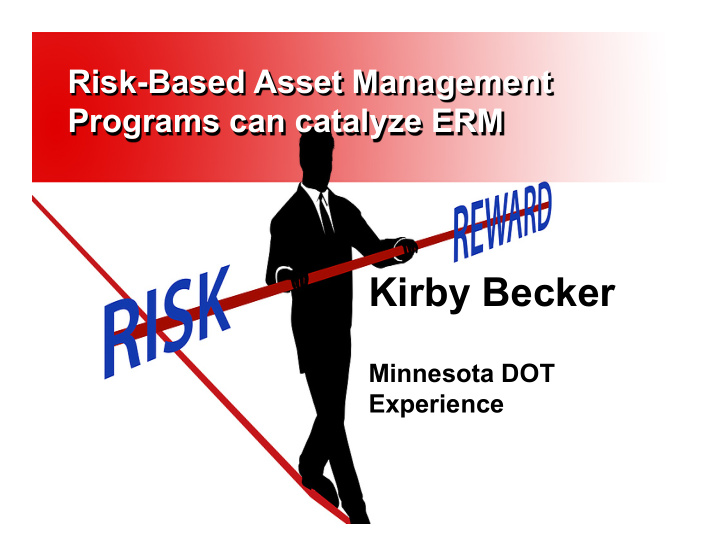



Risk-Based Asset Management Programs can catalyze ERM Kirby Becker Minnesota DOT Experience
How Risk-Based Asset Management Programs can Catalyze ERM 1:00 P.M. - Tuesday, August 25, 2015 2
§ Asset Management Planning Framework § MnDOT Risk Framework (including TAMP) § MnDOT Asset Performance § TAMP Lessons
§ Asset Inventory & Conditions § Risk Analysis § Life Cycle Cost Analysis § Performance Measures & Targets § Performance Gap Assessment § Financial Plan & Investment Strategies § Implementation & Next Steps
§ Risk Management at MnDOT § Enterprise Risk Management § 20-year State Highway Investment Plan (MnSHIP) § 4-year Highway Systems Operations Plan (HSOP) § Bridge Management (BRIM) § Pavement Management (HPMA) § MnDOT’s TAMP Risk Assessment process § “Global Risks” § “Undermanaged Risks” § Prioritization of mitigation strategies
§ Enterprise Risk Management
§ MnSHIP § Used risk as a lens, building on the 2010 Risk Profiles and focusing on 10 investment categories and risk to assess Plan investment direction Manage more? Tradeoffs Accept more?
§ Bridge and Pavement Management (BRIM/HPMA) § HPMA helps meet GASB 34 min. condition thresholds and risks associated with HPMA are identified in MnDOT’s ERM risk register § BRIM used to identify, evaluate, and plan for a variety of quantifiable risks that apply to bridges
§ TAMP Process included Identifying, Assessing, and Managing Asset Specific Risks § Impacts to assets, public, agency § Risk Evaluation Process § Likelihood/consequence of occurrence
§ Process began with focus on “global” risks § Natural events or operational hazards § Transitioned to an emphasis on “undermanaged” risks § Areas with clear opportunities for improvement – to better manage assets – as to avoid global risks § Identification/Prioritization of mitigation strategies
§ Redefining Targets from MnSHIP to TAMP § Terminology Moving Forward to Determine Performance Gap § Targets reflect desired outcomes § Plan outcomes describe future performance outcomes with MnDOT’s fiscally constrained spending priorities § Connecting Risk and to Asset and Performance Management
Pavement Existing & Recommended Condition Targets Bridge Existing & Recommended Condition Targets
Highway Culvert & Deep Stormwater Tunnel Existing & Recommended Condition Targets Overhead Sign Structures & High-Mast Light Tower Structures Existing & Recommended Condition Targets
§ Development of the TAMP helped justify improvements already being discussed § Complete bridge management tools to improve predictions of future conditions § Formalize the inspection of overhead sign structures and high-mast light tower structures to help reduce the risk of failure
§ TAMP framework served as a proof-of-concept for expanding the scope of future TAMPs for assets without formal management processes in place
§ Process of using existing data to develop the TAMP provided insight into the completeness and reliability of the data and a better understanding of the risks associated with undermanaging the assets § Potential risk of failure associated with the I-35W South deep stormwater tunnel contributed to MnDOT programming $12 million to address needed repairs § Plan led to the observation that there are many miles of access roads, ramps, frontage roads, and auxiliary lanes that are not currently being monitored and tracked (research underway)
§ MnDOT was able to uncover risks associated with undermanaging assets by focusing on risks associated with achieving the performance outcomes that had not previously been at the forefront § Need for prediction models to better manage bridges § Need for a formal inspection process for overhead sign structures and high-mast light tower structures.
For further information contact Kirby Becker Kirby.Becker@state.mn.us / (651) 366-3740 Or visit http://www.dot.state.mn.us/assetmanagement
Recommend
More recommend